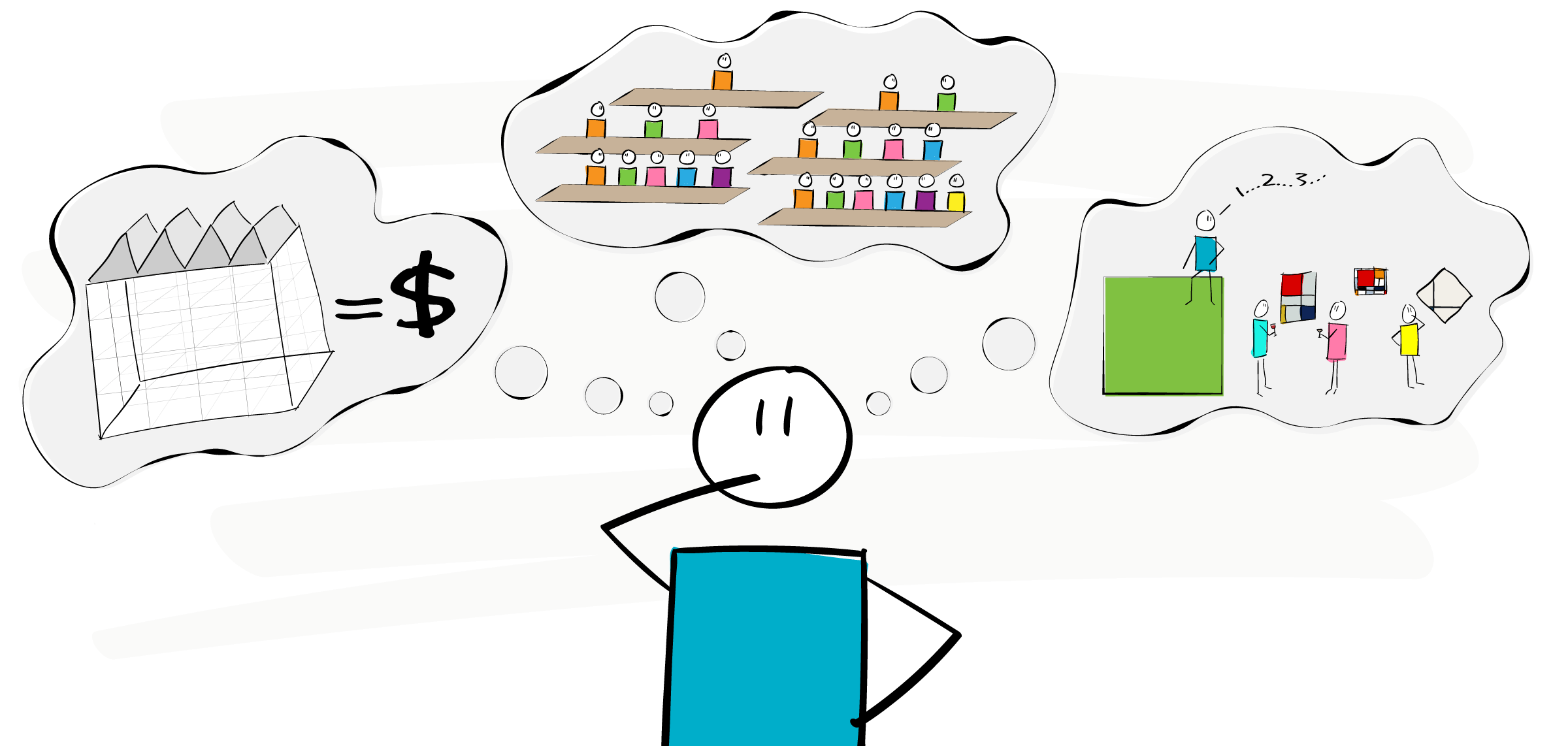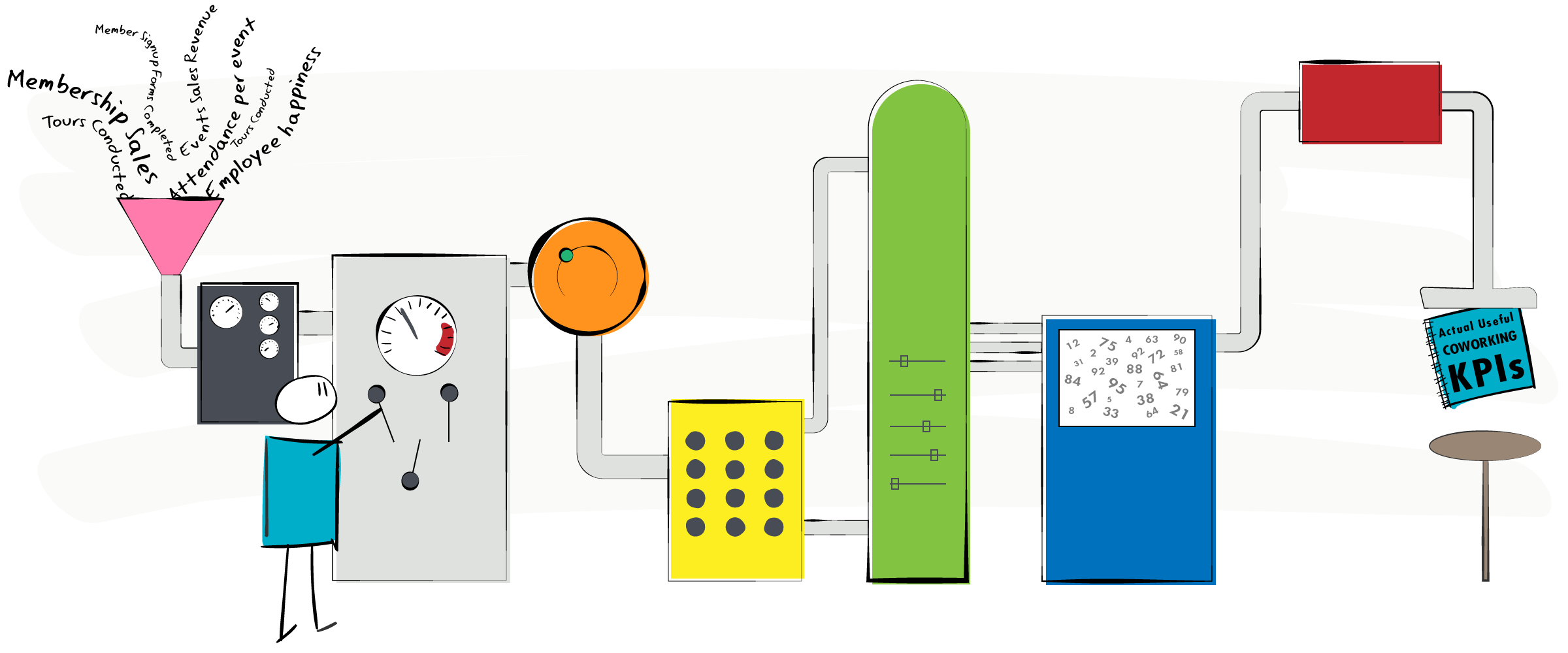Identifying Real Coworking KPIs

Measuring the wrong KPIs at the wrong time, as well as leaving gaps in your data tracking, turns most KPIs into useless vanity metrics. And following vanity metrics can lead your coworking business to ruin. However, there’s a way to avoid them, and it’s all about leverage and the KPI Hierarchy.
People talk about the importance of KPIs for coworking spaces all the time. They measure things such as income per square foot, member-to-workspace ratio, event attendance, tracking the number of weekly member connections, and much more.

All of those metrics are interesting pieces of data. However, they’re not important in all cases. They are, in many situations, vanity metrics.
Whether your KPIs come from an industry article on the topic, your boss, or your investors, the KPIs you track are often gathered from someone else. These people say track this; those people say track that. But these KPIs often become vanity metrics because they don't paint a complete picture of your coworking space business model. They are recipes from another chef, perhaps a chef that doesn't even cook your particular coworking cuisine.
Let's imagine that hundreds of people are showing up to your events, plus you have a positive 2:1 member-to-workspace ratio, and your income per square foot is $200 per month, and on average your members connect with twelve new people every week. Sounds good, right?
Wrong. Somehow at the end of the month, you still can't pay the bills.
It turns out that the expense of those huge events is eating into more than your income adds up to. What's worse, the reason your members are meeting so many new people is that you have too many members and not enough workspace. Your space is over-crowded, and your member churn is rapidly increasing.
So, what went wrong?
What went wrong was you were tracking an incomplete set of metrics, plus possibly metrics that are not important at this stage of your coworking business.
Let’s start at the beginning.
Imagine Jacqueline. She’s a new coworking space founder and has done many of the right things up front. She’s focused on a niche: coworking with childcare in the suburbs. She hosted popular weekly coworking meetups for several months leading up to the opening of her space. She started with 50% of the space filled from those attending the coworking meetups. She’s off to a great start because her offer is focused and she’s executing the right tactics for building her community.
Now, with growth in mind, Jacqueline wants to know what metrics to track. She’s read the articles, talked with colleagues and friends who own businesses. But coworking is so multi-faceted that she’s getting overwhelmed. The expert advice in the industry seems to tell her contradictory things. Plus something about measuring income per square foot feels off-brand to her.
Where should she start?
It All Starts with Sustainability
The best place for Jacqueline to begin setting out metrics is to start at the bottom, the bottom line that is. In other words, start with sustainability.
The most important metric you can measure is sustainability. Every other parameter you can measure stems from sustainability.
I opted against using the term profitability here because it implies maximizing profits, which comes at a later stage. Profitability requires sustainability first. You might think I’m playing with words here, but the mental shift is critical. You should not be overthinking profitability before you think about getting to break-even. Doing so prevents you from making the right moves to gain early traction. Profitability is a different problem to solve. In the beginning, it’s all about breaking even.
There are formulas for calculating break-even points, but I think they are too complicated for our analysis. The point of sustainability can be easily understood as when:
Income - Expenses = 0

Technically, if you haven’t even started your coworking space, you’re at breakeven. Congratulations! I’m suddenly reminded of the phrase, “don’t just do something, stand there!”
Jokes aside, sustainability is quite simple to understand and is our starting point for tracking all other metrics. The question we need to ask ourselves with every decision, every single day, is "will this get us to sustainability?" Or if you're already profitable, "could this make us unsustainable?”
Short-term unsustainability is fine so long as it’s temporary and serves a larger purpose, which includes getting back to sustainability.
KPIs Aren’t Always Positive
Before we move onto the KPIs that stem from sustainability, there's one important thing to keep in mind which most businesses, especially small-to-medium-sized ones, tend to overlook regarding KPI setup. They forget to track so-called "negative" KPIs. Measuring negative or cost-side KPIs is just as relevant as monitoring positive KPIs.
Most people remember to measure Negative KPIs like:
- Overall Expenses
- Cost per customer acquisition
- Fixed costs like rent and utilities
- Staffing costs
However, they often forget about a whole host of other, more nuanced Negative KPIs such as:
- Member churn (the rate at which members leave)
- Negative reviews
- Wifi downtime
- Employee turnover
Negative KPIs are essential to keep in mind because your goal is to reduce or eliminate their presence. Decreasing negative KPIs is typically the goal of an Operations Director.
Anyway, with that said, let’s move onto the KPI Hierarchy.
The KPI Hierarchy
The KPI Hierarchy can be seen as the overall structure and importance of individual KPIs as they relate to the whole. It starts with sustainability at the roots, and builds up from there. This means the further up you go, the less important any individual KPI is. It’s the node KPI and the strong base that make for a good KPI Hierarchy.
In some way, The KPI Hierarchy is similar to the sales or marketing funnel, but with one fundamental difference. Your KPI Hierarchy isn't merely tracking membership signups and sales. It's outlining the levers and mechanisms you can use to affect every part of your business.
The KPIs that can follow on from sustainability are vast, possibly even limitless. They can include things like this list below, but that’s just a small sample. It’s also overly focused on marketing because I’m a marketing guy and it’s something I obsess over!
Sample KPIs for your KPI Hierarchy:
- Membership Sales
- Member Signup Forms Completed
- Tours Conducted
- Audience-relevant Events Hosted
- Attendance per event
- Online Signups (w/o Tour)
- Number of Membership Inquiries by Source
- Events Sales Revenue
- Event Add-ons Pitched
- Event Inquiry Reply Time
- Number of Event Inquiries by Source
- Employee turnover
- Employee happiness
- Employee work-related and personal goals met
- Number of 1:1s per month w/each employee

That's barely the tip of the iceberg. The crucial bit here is not to include every KPI imaginable but to include the KPIs relevant to you and your stage of operations. In later sections, we'll cover how to do precisely that.
KPI-Action Pairs
One important thing to keep in mind regarding KPIs is why they exist in the first place. KPIs map to the actions taken to improve your business. There’s no such thing as a KPI without an action. We can call these KPI-Action Pairs.
Now, a single KPI may have multiple actions that map to it. After all, that is the whole point of measuring the KPI in the first place: to see which actions correlate to its improvement.
Here are a few examples of KPI-Action pairs:
- The number of online membership sign-ups pairs with the form and function of the membership sales page
- Online membership sign-ups could also pair with the one-time offer you show to new signups who are about to leave the page, giving them 50% off their first three months
- The number of tours conducted pairs with the automated reminder email sent to people who’ve scheduled tours
- The measurable quality of the front entrance greeting pairs with the organic muffin and coffee you gave to your front desk associate earlier that morning
There are far more KPI-Action Pairs than there are KPIs, and I understand it can sound a bit nebulous. However, there’s no need to get too into the weeds here. Just keep in mind that KPIs map to actions, and vice versa. Also remember that a single KPI can map to dozens, if not hundreds, of actions.
Vanity Metrics Fail to Create Leverage
Let’s get back to Jacqueline. Let’s say she’s increased her newsletter signups 300% and her email open rate by 20%. That’s great news! However, those metrics don’t matter in the slightest if they don’t affect how many people sign up for tours or membership at Jacqueline’s space, leaving her bottom line unaffected.
KPIs like this are called vanity metrics because, while increasing them makes us look good and feel like we’re progressing, the actions they are measuring don’t create any leverage over our business performance. These KPIs and their related activities will neither get us to sustainability, nor to profitability.
Vanity Metrics Can Be Useful
While continuing to focus on vanity metrics is bad, their discovery is a good thing. Nobody gets KPIs right on day one. That's because figuring out what to track is a process of discovering which activities improve various aspects of your business and which do not.
For example, if Jacqueline doubles her Twitter following, but her post engagement barely nudges, then Twitter followers are a vanity metric for her. The lever she needs to pull is not getting more followers but creating more engaging content that attracts her core audience.
Likewise, if your Facebook engagement has gone through the roof, but traffic to your website from that channel has only marginally increased, then Facebook engagement is, you guessed it, a vanity metric (unless, of course, you’re using Facebook as your primary platform for your business instead of a website!). These signs tell us it's time to change course and find out where the leverage is.
In the case above, the lever you need to pull isn't creating ever more engaging Facebook content. Instead, you may need to shift your content marketing strategy to throw more "right hooks" as Gary Vaynerchuk calls them. In other words, you need to ask people to sign up, stop by for a visit, come to an event, etc. Then again, the problem may be something else entirely. It could be that you're creating content which is engaging an audience which isn’t the small group of people who live in your area and are looking for a coworking space. It may be the case that the time you spend on Facebook could be better spent elsewhere to get better results.
Metrics like social media followers, post engagement, open rate, etc. are, in most cases, easy to identify as vanity metrics. However, all of the KPIs in the list above can also be vanity metrics if their positive development doesn’t affect the metrics immediately beneath them on your KPI Hierarchy.
Neither the activities, nor the worrying about KPIs related to them, matter if they don’t affect each subsequent metric down through to sustainability.
Missing KPIs in Your Hierarchy
The most common reason people feel like they aren’t gaining traction and don’t know which KPIs to track has to do with unidentified gaps in their KPI Hierarchy. You might think taking action in one KPI area will improve a metric further down the KPI Hierarchy, but in reality, you could be skipping over one or several KPIs, whereupon without taking a particular action, no improvement can happen.
For example, online membership sign-ups might seem like they're the immediate underlying KPI of overall website traffic, but that’s not the case. In fact, traffic to the membership pricing page is the missing metric that fits neatly in between the two identified KPIs. That means better design, copy, or some other feature on the website could, therefore, be the real leverage point.
The simple way to identify missing KPIs, and therefore actionable areas, is to try to improve one KPI in your hierarchy, then see if it improves the KPI immediately beneath it. If it doesn’t, you’re likely missing an important and trackable metric between the two. In the example of online signups, you can think about what other micro steps the user is taking to help identify what’s missing. From there, you must see an improvement in overall sustainability or profitability as well. If you don’t see an improvement to you bottomline, you still have gaps.
KPI Importance Changes Over Time
But that's not all folks. Just because you've found a leverage point in your business doesn't mean it will stay that way. The leverage of any action that you're tracking with your KPIs tends to wane over time. At some point, you'll have to rethink the importance of your chosen KPIs.
For example, you may have recognized the significant impact of events on membership sign-ups two years ago. However, if you’ve begun to see increasingly diminishing returns, it’s time to find other levers to pull.
It’s not all about the money.
While I said every KPI needs to track back to sustainability, KPIs aren’t always about money. I do hold the position that sustainability must be your primary objective. Without it, you will no longer exist to serve the people in your space.
That said, your KPI Hierarchy can include many non-business oriented things. That’s the idea behind the triple bottom line, which involves tracking three primary metrics:
- People
- Purpose
- Profit
Your goal may be to increase employee happiness for no other reason than you like to work with happy people. Another aim might be to contribute positively to your local neighborhood because that’s the place you want to live, walk, work, and play.
I believe all non-monetary metrics still correlate to your bottom line in one way or another. However, it's okay, great even, to have KPIs which reduce your profitability but instead serve you and your community in some other, non-financial, way. After all, the reason we're building coworking spaces in the first place has a lot more to do with purpose and people, than it does with profit.
Never miss a beat!
Want to see it in action?
Marketing Director, founder at Coworking Insights, coworking maven, digital nomad, lover of wine & tacos.



